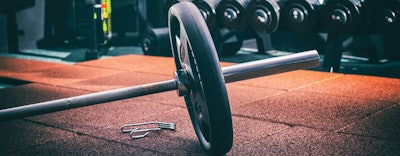
Perhaps more than any other space within your facility, the weight room is a hostile environment that demands a flooring surface that can take a beating — including hundreds of pounds of weights and countless beads of sweat being dropped on it. The surface you choose will need to offer excellent durability, traction and ease of maintenance. Here are a few things to consider when you're selecting the right flooring for your weight room:
RELATED: PRODUCT SPOTLIGHT 2019: Weight Rooms & Strength Equipment
Use-case
Perhaps the first thing you'll want to decide when shopping for weight room flooring is what types of strength training your space will support. Will you want a turf area for functional fitness? How much space will be taken up by power racks? Benches? Dumbbells? Barbells? Will the surface accommodate stationary selectorized equipment or be subjected to impact stresses from free weights? Depending on the answers to these questions, you may need more than one type of surface. Ask your provider what combination they suggest to meet the needs of those who will be using your space.
Roll versus interlocking systems
There are a number of manufacturers of rubber flooring, which means there are a range of prices and quality. Some providers offer interlocking tile systems, while others offer large rolls of recycled rubber (similar to carpet), which come in various thicknesses. Some of the lower-cost systems may even allow for self-installation, depending on your budget and the size of the project.
RELATED: Selectorized Weight Training Equipment Offers Options for All Users
Construction
While rolls of recycled rubber may do the job for some facilities, collegiate and some high school athletics programs may require athlete performance considerations. In those instances, tile systems that use layers of material may be the right fit. While more expensive, these systems employ vulcanized rubber and may include a non-porous hardened surface layer — which will resist punctures and tearing — as well as shock- and noise-absorbing underlayers that are easier on joints and muscles. Without being too soft, these systems can offer support for athletes doing heavy lifting, while also lowering injury risk.
Maintenance and bacteria resistance
Weight room floors collect a lot of sweat and grime, making them an excellent breeding ground for mold and bacteria. Be sure to ask your provider about what type of maintenance your chosen surface will require and whether it's resistant to mold. Some manufacturers actually promote their flooring's resistance to well-known superbugs such as MRSA.
RELATED: Find more solutions for your facility in the Buyers Guide
Customization
Weight rooms can be high-energy places, where any bit of inspiration might mean one more rep. In some cases that extra push may come in the form of a reminder of school pride, or a motivational mantra. Some manufacturers will offer complete customization of your weight room floor, which includes planning out branding elements such as color schemes and designs, as well as inlaid logo placement.
This article originally appeared in the October 2019 issue of Athletic Business with the title "Purchasing Guide" Athletic Business is a free magazine for professionals in the athletic, fitness and recreation industry. Click here to subscribe.




































